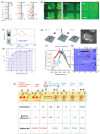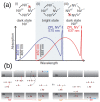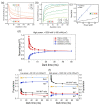Advances in Stabilization and Enrichment of Shallow Nitrogen-Vacancy Centers in Diamond for Biosensing and Spin-Polarization Transfer
- PMID: 37504090
- PMCID: PMC10377017
- DOI: 10.3390/bios13070691
Advances in Stabilization and Enrichment of Shallow Nitrogen-Vacancy Centers in Diamond for Biosensing and Spin-Polarization Transfer
Abstract
Negatively charged nitrogen-vacancy (NV-) centers in diamond have unique magneto-optical properties, such as high fluorescence, single-photon generation, millisecond-long coherence times, and the ability to initialize and read the spin state using purely optical means. This makes NV- centers a powerful sensing tool for a range of applications, including magnetometry, electrometry, and thermometry. Biocompatible NV-rich nanodiamonds find application in cellular microscopy, nanoscopy, and in vivo imaging. NV- centers can also detect electron spins, paramagnetic agents, and nuclear spins. Techniques have been developed to hyperpolarize 14N, 15N, and 13C nuclear spins, which could open up new perspectives in NMR and MRI. However, defects on the diamond surface, such as hydrogen, vacancies, and trapping states, can reduce the stability of NV- in favor of the neutral form (NV0), which lacks the same properties. Laser irradiation can also lead to charge-state switching and a reduction in the number of NV- centers. Efforts have been made to improve stability through diamond substrate doping, proper annealing and surface termination, laser irradiation, and electric or electrochemical tuning of the surface potential. This article discusses advances in the stabilization and enrichment of shallow NV- ensembles, describing strategies for improving the quality of diamond devices for sensing and spin-polarization transfer applications. Selected applications in the field of biosensing are discussed in more depth.
Keywords: NV center; biosensing; charge stabilization; nanodiamonds.
Conflict of interest statement
The authors declare no conflict of interest.
Figures









Similar articles
-
Divergent Effects of Laser Irradiation on Ensembles of Nitrogen-Vacancy Centers in Bulk and Nanodiamonds: Implications for Biosensing.Nanoscale Res Lett. 2022 Sep 26;17(1):95. doi: 10.1186/s11671-022-03723-2. Nanoscale Res Lett. 2022. PMID: 36161373 Free PMC article.
-
Modulation of nitrogen vacancy charge state and fluorescence in nanodiamonds using electrochemical potential.Proc Natl Acad Sci U S A. 2016 Apr 12;113(15):3938-43. doi: 10.1073/pnas.1504451113. Epub 2016 Mar 24. Proc Natl Acad Sci U S A. 2016. PMID: 27035935 Free PMC article.
-
Long-Lived Ensembles of Shallow NV- Centers in Flat and Nanostructured Diamonds by Photoconversion.ACS Appl Mater Interfaces. 2021 Sep 15;13(36):43221-43232. doi: 10.1021/acsami.1c09825. Epub 2021 Sep 1. ACS Appl Mater Interfaces. 2021. PMID: 34468122 Free PMC article.
-
Relaxometry with Nitrogen Vacancy (NV) Centers in Diamond.Acc Chem Res. 2022 Dec 20;55(24):3572-3580. doi: 10.1021/acs.accounts.2c00520. Epub 2022 Dec 7. Acc Chem Res. 2022. PMID: 36475573 Free PMC article. Review.
-
Nitrogen-vacancy centers in diamond: nanoscale sensors for physics and biology.Annu Rev Phys Chem. 2014;65:83-105. doi: 10.1146/annurev-physchem-040513-103659. Epub 2013 Nov 21. Annu Rev Phys Chem. 2014. PMID: 24274702 Review.
References
-
- Beveratos A., Kühn S., Brouri R., Gacoin T., Poizat J.P., Grangier P. Room temperature stable single-photon source. Eur. Phys. J. D-At. Mol. Opt. Plasma Phys. 2002;18:191–196. doi: 10.1140/epjd/e20020023. - DOI
-
- Schröder T., Gädeke F., Banholzer M.J., Benson O. Ultrabright and efficient single-photon generation based on nitrogen-vacancy centres in nanodiamonds on a solid immersion lens. New J. Phys. 2011;13:055017. doi: 10.1088/1367-2630/13/5/055017. - DOI

